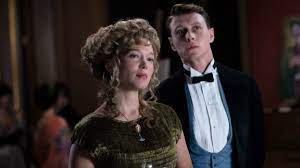252 total views, 1 views today
The Beast 2023 Movie Review
Do Androids Dream of Electric Sheep? is the name of the Philip K. Dick novel that Ridley Scott famously adapted into Blade Runner. Wading into similar dystopian sci-fi waters, Bertrand Bonello’s latest feature, The Beast (La Bête), tosses together so many ideas, time periods and genres, its source material could have been called: Do French Girls Dream of Androids While Trying to Escape from Incels in L.A. After the 1910 Paris Flood?
In reality, the auteur’s ambitious new 146-minute film is a very loose adaptation of the 1903 Henry James novella, The Beast in the Jungle, about a man who never pursues the woman he loves because he fears a terrible fate will befall him — until he realizes, way too late, that he made his fate come true by never pursuing her. Bonello takes that initial conundrum, slices, dices and remixes it, then tosses it into a time machine. He also switches up the protagonist to be the female character, played here by Léa Seydoux, while her love interest, played by British actor George MacKay (1917), transforms at one point into a violent American stalker recording creepy confessions on Facebook Live.
Set simultaneously in 2044, 2014 and in the belle-époque Paris of 1910, when the Seine overflowed and plunged parts of the city underwater, The Beast is at once an anxiety-ridden romantic thriller and a conceptual cri de coeur about the possible end of humanity. It features incredibly lifelike robots, exposed green screens, freaky ceramic dolls, and scenes of Seydoux doing futuristic hot yoga and dancing to trap while high on molly.
What it doesn’t always have is dramatic conflict, losing its staying power in a story that takes so many unexpected turns, it can feel as if Bonello is grasping at theoretical straws rather than weaving together a strong narrative. In that sense, The Beast is closest to his 2022 COVID-inspired cinematic essay, Coma, which also combined different genres and mediums — and which, like this film, will play best to Bonello’s small but loyal fan base.
Filled with the same impeccable sense of craft found in Saint Laurent and the rest of the director’s work, including stylish interiors by production designer Katia Wyszkop and fluid, aspect-ratio-switching photography by regular DP Josée Deshaies, the film maintains a certain level of suspense as it leaps between various epochs, often without warning. But, like many of Bonello’s movies, it lacks forward momentum and a sharp edit, lumbering along as it reaches into a grab bag of thematic and aesthetic concepts.
The framing device is the 2044 story, with Seydoux’s Gabrielle living in a post-apocalyptic Paris filled with empty streets and friendly androids, and where artificial intelligence has rendered human beings all but redundant. The powers-that-be suggest turning Gabrielle into a semi-robot as well, offering to modify her DNA and relieve her of any emotions, in a surgical procedure recalling the black slime bath in Jonathan Glazer’s Under the Skin.
During the operation she hallucinates, dreams or remembers her past lives — starting in 1910, when she meets the shy but dashing Louis (MacKay) at a society ball. The two immediately have a connection, as if they’ve known each other for years, and soon they start meeting up in Paris, including a visit to the doll factory of Gabrielle’s husband.
That setting is strange indeed, with Bonello focusing on the factory’s new production methods that result in much more realistic toys — and the earliest prototypes of the state-of-the-art androids we see in 2044. The Beast is loaded with such connections — between past and present, old technologies and new ones, disasters that have already occurred and those to come — to the point that they become the main focus of the movie. It doesn’t necessarily make for thrilling cinema, but for those interested in following Bonello down a trippy rabbit hole where history keeps repeating itself, it can certainly be intriguing.
The film’s long final section, set in Los Angeles in 2014, follows Gabrielle as she house-sits a bodacious modernist mansion while trying to make it as an actress and model. Clearly a satire on celebrity, social media and, well, L.A. — and one that includes a cameo by actress/Red Scare podcast host Dasha Nekrasova — it makes some rather obvious if pertinent points about our troubled times. The bits with MacKay playing an incel who’s ready to go postal at any moment feel particularly overblown, as if Bonello were engaging in anthropological tourism, offering a scathing commentary on America that David Lynch pulled off much more eloquently in films like Lost Highway and Mulholland Drive.
The comparison seems apt, especially when Bonello uses Roy Orbison’s very Lynchian song, “Evergreen,” as constant background music that plays on a karaoke channel Gabrielle never turns off. Other pop tracks pepper the movie, many of them heard in a futuristic disco specializing in retro soirées hopping from the 60s to the 70s to the 80s (a device used in another Gallic adaptation of the James story, simply called The Beast in the Jungle, currently out in French theaters). Like the plot itself, the music forms a feedback loop that keeps repeating with new variations, taking Gabrielle back to where she started.
Compared to recent performances, Seydoux feels more subdued here, almost robot-like at times — a comparison that Bonello deliberately makes when, at one moment, she freezes up for a few long seconds, as if she were a ceramic doll herself. The film in fact begins with the Palme d’Or winning actress playing a scene in a digital studio, pretending to escape a monster in front of a giant green screen. It immediately takes us out of the action and prepares us for what’s to come, which again seems to be the point: Bonello doesn’t want us to simply watch The Beast, but to pay attention to it.
